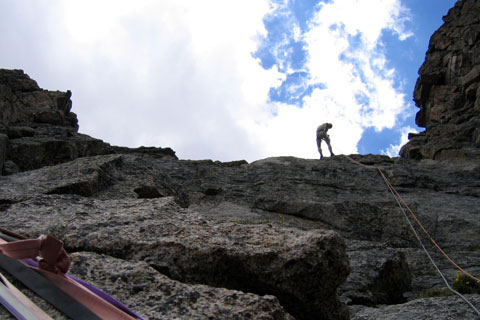| 324 | Jump | 2010-12-24 |

Sky diving can be a dangerous sport. The sport is much like rappelling in that you are totally dependent on your gear; but there is also skill involved to keep from overtaxing the gear used. In rappelling it is scary to think that you are hanging suspended in a death defying fall, hanging solely from a, presumably, safe climbing rope. Sky diving is even worse - it is that first step and more.
I would not even think of trying to parachute without instructions. Even though the procedure seems fairly straight forward ... jump, pull the rip cord, and land - I know that there is more to the sport than those simple instructions. You take lessons and practice before you are able to free fall and accomplish difficult maneuvers. You know that one mistake could be your last.
It's odd to me, that a sane person would not try to jump out of a plane without some knowledge of the techniques; yet sane, novice hikers, climbers, and mountaineers routinely try routes they do not have the skill or experience to safely accomplish. Naively, they push themselves deeper into trouble. They "jump" without knowing the procedures. As they near their impending doom they push the panic button on the SPOT or phone 911.
A couple years ago we, my wife and I, were climbing Mount Quandry in late June. There was a lot of snow and it was very cold and windy high on the mountain. As we were descending from the summit, just below tree line we met a family that looked like they were headed for a picnic on a beach. They wore shorts, sandals, and lightweight jackets. They asked us how much further it was to the top and did we think they could make it. Holding back our true comments, we just told them, "no!"
A recent incident about the hiker who tried to climb the Barr Trail in winter conditions is a prime example of this mentality. The climb is 13 miles, 8,000 foot one way. The hiker spent the night on top and, because he could not get a signal from inside the shelter he found, he could not contact his sister, and a rescue was initiated. I am glad that the hiker found safety and survived the night; but his actions were wrong. His inexperience was obvious when he kept going up, knowing he would not make the summit and return to meet his sister at the agreed upon time. He was jumping out of the plane without the first lesson and, oddly enough, he did not even know it.
Backcountry travel is dangerous, but to the uninitiated it can seem so easy. All you have to do is put one foot in front of the other, all you have to do is "jump". From the novice to the pro the lessons learned from the miles of experience allow safe passages. Novices need to practice at novice levels of endeavors. They will know when it is time to move up to the next level. Always keep a safety net of strength and experience in reserve to temper even the harshest of times and one day the novice will be the pro. But, we all need to learn before we jump.
Happy safe trails.
